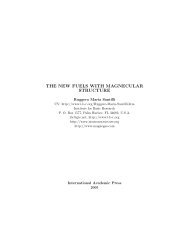Toroidal configuration of the orbit of the electron of the hydrogen ...
Toroidal configuration of the orbit of the electron of the hydrogen ...
Toroidal configuration of the orbit of the electron of the hydrogen ...
You also want an ePaper? Increase the reach of your titles
YUMPU automatically turns print PDFs into web optimized ePapers that Google loves.
depend on it. In <strong>the</strong> next Section, we approximate <strong>the</strong> effective potentialC(z) with a better accuracy.3.1.2 The modified Coulomb potential approximationWe note that due to <strong>the</strong> exact result (3.5), <strong>the</strong> effective potential C(z) tendsto zero as z → ∞ (not a surprise). However, a remarkable implication <strong>of</strong> <strong>the</strong>exact result is that C(z) is finite at z = 0, namely,C(0) = − √ πγ e 2 , (3.26)so that <strong>the</strong> effective potential C(z) indeed can not be well approximatedby <strong>the</strong> Coulomb potential, −e 2 /|z|, at small z (|z| < 10 −8 cm) despite <strong>the</strong>fact that at big values <strong>of</strong> γ (γ ≫ γ 0 ≃ 1.7 · 10 16 cm −2 ) <strong>the</strong> Coulomb potentialreproduces C(z) to a good accuracy at long and medium distances.Thus, <strong>the</strong> approximation considered in Sect. 3.1.1 appears to be not valid at(important) short distances.Consequently, Eq. (3.4) with <strong>the</strong> exactly calculated C(z) will yield <strong>the</strong>ground state <strong>of</strong> <strong>electron</strong> in <strong>the</strong> z direction which is drastically different fromthat with <strong>the</strong> Coulomb potential considered in Sect. 3.1.1. Thus, very intensemagnetic field essentially affects dynamics <strong>of</strong> <strong>electron</strong> not only in <strong>the</strong> (r, ϕ)plane but also in <strong>the</strong> z direction. We expect that for <strong>the</strong> case <strong>of</strong> exactpotential (3.5) <strong>the</strong> ground state is characterized by much lower energy in <strong>the</strong>z direction as compared to that <strong>of</strong> <strong>the</strong> one-dimensional Bohr state (3.23).The exact potential C(z) can be well approximated by <strong>the</strong> modifiedCoulomb potential,e2C(z) ≃ V (z) = − , (3.27)|z| + z 0where z 0 is a parameter, z 0 ≠ 0, which depends on <strong>the</strong> field intensity B duetoz 0 = − e2C(0) = √ 1√2¯hc= πγ πeB . (3.28)The analytic advantage <strong>of</strong> this approximation is that V (z) is finite at z = 0,being <strong>of</strong> Coulomb-type form.Calculations for this approximate potential can be made in an essentially<strong>the</strong> same way as in <strong>the</strong> preceding Section, with |x| being replaced by |x|+x 0 ,19














